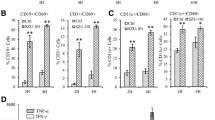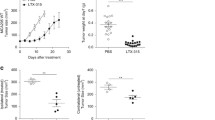Abstract
The antitumor activity of a combination of an antitumor polysaccharide, lentinan (a β1–3 glucan with β1–6 branches), and interleukin-2 (IL-2) was evaluated against established MBL-2 lymphoma and S908.D2 sarcoma at i.d. sites. Treatment of the MBL-2-tumor-bearing BDF1 mice with lentinan and IL-2 induced complete regression of tumor in 87.5% of mice treated. In contrast, treatments using either lentinan or IL-2 alone failed to induce complete regression of tumor, although temporal growth inhibition of tumor was observed about in half of the mice treated. Improvements of antitumor effects by the combination of lentinan and IL-2 were also observed in the MBL-2/B6 and S908.D2/B10.D2 systems. Expression of the antitumor effects of lentinan/IL-2 treatments required the intact T cell compartment, because the effects were not observed when nude mice were used. In the MBL-2/B6 system, the antitumor action of lentinan/IL-2 treatment was abolished in mice treated with antibody to CD8 antigen, whereas antibodies to CD4 or NK1.1 were ineffective. Furthermore, augmented tumor-specific cytotoxic T lymphocyte (CTL) activity was observed in regional lymph node cells of the mice after lentinan and IL-2 administration. These data indicate that the antitumor effects of lentinan/IL-2 are mediated by CD8+ CTL but not by CD4+ T cells or NK1.1+ NK/LAK cells, and suggest that this combined therapy may be effective against even established tumors that are resistant to IL-2 therapy.
Similar content being viewed by others
Abbreviations
- B6:
-
C57BL/6
- BDF1:
-
C57BL/6 × DBA/2 F1
- Lyt2:
-
murine CD8α, Lyt2.1. allele of murine CD8
- Lyt2.2:
-
allele of murine CD8
- Lyt3:
-
murine CD8β
- L3T4:
-
murine CD4
References
Baume DM, Caligiuri MA, Manley TJ, Daley JF, Ritz J (1990) Differential expression of CD8a and CD8b associated with MHC-restricted and non-MHC-restricted cytolytic effector cells. Cell Immunol 131: 352
Brunda MJ, Bellantori D, Sulich V (1987) In vivo anti-tumor activity of combinations of interferon alpha and interleukin-2 in a murine model. Correlation of efficacy with the induction of cytotoxic cells resembling natural killer cells. Int J Cancer 40: 365
Burger CJ, Elgert K, Farrar W (1984) Interleukin 2 (IL-2) activity during tumor growth: IL-2 production kinetics, absorption of and responses to exogenous IL-2. Cell Immunol 84: 228
Burnet FM (1970) Immunological surveillance. Pergamon Press, Oxford
Cameron RB, McIntosh JK, Rosenberg SA (1988) Synergistic antitumor effects of combination immunotherapy with recombinant interleukin-2 and a recombinant hybrid α-interferon in the treatment of established murine hepatic metastases. Cancer Res 48: 5810
Ciolli V, Gabriele L, Sestili P, Varano F, Proietti E, Gresser I, Testa U, Montesoro E, Bulgarini D, Mariani G, Peschle C, Belardelli F (1991) Combined interleukin 1/interleukin 2 therapy of mice injected with highly metastatic friend leukemia cells: host antitumor mechanisms and marked effects on established metastases. J Exp Med 173: 313
Dialynas DP, Quan ZS, Wall KA, Pires A, Quintous J, Loken MR, Pierres M, Fitch FW (1983) Characterization of the murine T cell surface molecule, designated L3T4, identified by monoclonal antibody GK1.5: similarity of L3T4 to the human Leu3/T4 molecule. J Immunol 131: 2245
Hamuro J, Chihara G (1985) Lentinan, a T-cell-oriented immunopotentiator: its experimental and clinical applications and possible mechanism of immune modulation. In: Feniche RL (ed) Immune modulation agents and their mechanisms. Dekker New York, p 409
Hamuro J, Roellinghoff M, Wagner H (1978) β(1–3)glucan-mediated augmentation of alloreactive murine cytotoxic T lymphocytes in vivo. Cancer Res 38: 3080
Herbermen RB, Nunn-Hargrove ME (1981) Augmentation of natural killer (NK) cell activity by lentinan. In: Aoki T (ed) Manipulation of host defense mechanisms. Excerpta Medica, Amsterdam, p 188
Hosokawa M, Sawamura Y, Morikage T, Okada F, Xu Z, Morikawa K, Itoh K, Kobayashi H (1988) Improved therapeutic effects of interleukin 2 after the accumulation of lymphokine-activated killer cells in tumor tissue of mice previously treated wih cyclophosphamide. Cancer Immunol Immunother 26: 250
Kalland T, Belfrage H, Bhiladvala P, Hedlund G (1987) Analysis of the murine lymphokine-activated killer (LAK) cells: dissection of effecter and progenitor into NK- and T-like cells. J Immunol 138: 3640
Koo GC, Dumont FJ, Tutt M, Hackett J, Kumar V (1986) The NK.11(−) mouse: a model to study differentiation of murine NK cells. J Immunol 137: 3742
Maeda Y, Watanabe ST, Chihara G, Rokutanda M (1984) T-cell mediated vascular dilatation and hemorrhage induced by antitumor polysaccharides. Int J Immunopharmacol 6: 493
Maghazachi AA, Fizgibbon L (1990) Fate of intravenously administered rat lymphokine-activated killer cells labeled with different markers. Cancer Immunol Immunother 31: 139
McIntosh JK, Mule JJ, Krosnick JA, Rosenberg SA (1989) Combination cytokine immunotherapy with tumor necrosis factor α, interleukin 2, α-interferon and its synergistic antitumor effects in mice. Cancer Res 49: 1408
Moller G (1986) IL-2: receptors and genes: Immunol Rev 92
Mule JI, Shu S, Schwartz SL, Rosenberg SA (1984) Adoptive immunotherapy of established pulmonary metastasis with LAK cells and recombinant interleukin-2. Science 225: 1487
Mule JJ, Yang JC, Afreniere R, Shu S, Rosenberg SA (1987) Identification of cellular mechanisms operational in vivo during the regression of established pulmonary metastases by the systemic administration of high-dose recombinant interleukin 2. J Immunol 139: 285
Nakayama E, Uenaka A (1985) Effects of in vivo administration of Lyt antibodies. Lyt phenotype of T cells in lymphoid tissues and blocking of tumor rejection. J Exp Med 161: 345
Parkinson DR (1988) Interleukin-2 in cancer therapy. Semin Oncol 15: 10
Peace DJ, Cheever MA (1989) Toxicity and therapeutic efficacy of high-dose interleukin-2. J Exp Med 169: 161
Phillips J, Lanier LL (1986) Dissection of the lymphokine-activated killer phenomenon: relative contribution of peripheral blood natural killer cells and T lymphocytes to cytolysis. J Exp Med 164: 814
Plate F, Gomard E, Leclerc JC, Levy JP (1973) Further evidence for the involvement of thymus-processed lymphocytes in syngeneic tumor cell cytolysis. J Immunol 111: 667
Rosenberg SA (1988) Immunotherapy of cancer using interleukin 2: current status and future prospects. Immunol Today 9: 58
Rosenberg SA, Lotze MT, Muul LM, Chang AE, Avis FP, Leitman S, Linehan M, Robertson CN, Lee RE, Rubin JT, Seipp CA, Simpson CG, White DE (1987) A progress report on the treatment of 157 patients with advanced cancer using lymphokine activated killer cells and interleukin-2 or high dose interleukin-2 alone. N Engl J Med 316: 889
Sasaki A, Jain RK, Maghazachi AA, Goldfarb RH, Herbermann RB (1989) Low deformability of lymphokine-activated killer cells as a possible determinant of in vivo distribution. Cancer Res 49: 3742
Satoh T, Matsui H, Shibahara S, Kobayashi T, Morinaga Y, Kashima N, Yamasaki S, Hamuro J, Taniguchi T (1987) New approaches for the high-level expression of human interleukin-2 cDNA inEscherichia coli. J Biochem (Tokyo) 101: 525
Smith KA (1988) Interleukin-2: inception, impact, and implications. Science 240: 1169
Snick VS (1990) Interleukin-6: an overview. Annu Rev Immunol 8: 253
Suga T, Izawa M, Yamashita A, Chihara G (1990) Infiltration of host cells in local tumor site triggered by the administration of anti-tumor polysaccharide, lentinan. In: Masihi KN (ed) Immunotherapeutic prospects of infectious diseases. Springer-Verlag, Berlin Heidelberg New York, p 188
Suttles J, Schwazting GA, Stout RD (1986) Flow cytometric analysis revealed the presence of asialo GM1 on the surface membrane of alloimmune cytotoxic T lymphocytes. J Immunol 136: 1586
Suzuki M, Higuchi S, Taki Y, Taki S, Miwa K, Hamuro J (1990) Induction of endogenous lymphokine-activated killer activity by combined administration of lentinan and interleukin 2. Int J Immunopharmacol 12: 613
Suzuki M, Higuchi S, Kikuchi T (1990) Role of IL-6 production on augmentation of accessory cell function by lentinan. Biotherapy 4: 696
Taniguchi T, Matsui H, Fujita T, Takioka C, Kashima N, Yoshimoto R, Hamuro J (1983) Structure and expression of a cloned cDNA for human interleukin-2. Nature 302: 305
Author information
Authors and Affiliations
Rights and permissions
About this article
Cite this article
Suzuki, M., Kikuchi, T., Takatsuki, F. et al. Curative effects of combination therapy with lentinan and interleukin-2 against established murine tumors, and the role of CD8-positive T cells. Cancer Immunol Immunother 38, 1–8 (1994). https://doi.org/10.1007/BF01517163
Received:
Accepted:
Issue Date:
DOI: https://doi.org/10.1007/BF01517163




